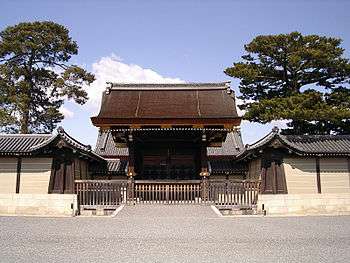Imperial Court in Kyoto
| Pre-modern Japan | |
|---|---|
 | |
|
| |
Chancellor / Chief Minister | Daijō-daijin |
| Minister of the Left | Sadaijin |
| Minister of the Right | Udaijin |
| Minister of the Center | Naidaijin |
| Major Counselor | Dainagon |
| Middle Counselor | Chūnagon |
| Minor Counselor | Shōnagon |
| Eight Ministries | |
| Center | Nakatsukasa-shō |
| Ceremonial | Shikibu-shō |
| Civil Administration | Jibu-shō |
| Popular Affairs | Minbu-shō |
| Military | Hyōbu-shō |
| Justice | Gyōbu-shō |
| Treasury | Ōkura-shō |
| Imperial Household | Kunai-shō |
|
| |

Front view of Kyoto Imperial Palace
The Imperial Court in Kyoto was the nominal ruling government of Japan from 794 AD until the Meiji period (1868–1912), after which the court was moved from Kyoto to Tokyo and integrated into the Meiji government. The shogunate system came after the Imperial Court, with Minamoto no Yoritomo being the first to establish the post of the Shogun as hereditary, in 1192.
Since Minamoto no Yoritomo launched the shogunate, true power has been in the hand of the Shoguns, who were mistaken several times for the Emperors of Japan by western countries.
See also
Further reading
- Ackroyd, Joyce. (1982). [ Arai Hakuseki, 1712] Tokushi yoron; "Lessons from History: the Tokushi yoron" translated by Joynce Ackroyd. Brisbane: University of Queensland Press. ISBN 0-7022-1485-X
- (Japanese) Asai T. (1985). Nyokan Tūkai. Tokyo: Kōdansha.
- Brown, Delmer and Ichiro Ishida, eds. (1979). [ Jien, c.1220], Gukanshō; "The Future and the Past: a translation and study of the 'Gukanshō,' an interpretive history of Japan written in 1219" translated from the Japanese and edited by Delmer M. Brown & Ichirō Ishida. Berkeley: University of California Press. ISBN 0-520-03460-0
- Ozaki, Yukio. (2001). The Autobiography of Ozaki Yukio: The Struggle for Constitutional Government in Japan. [Translated by Fujiko Hara]. Princeton: Princeton University Press. ISBN 0-691-05095-3 (cloth)
- (Japanese) Ozaki, Yukio. (1955). Ozak Gakudō Zenshū. Tokyo: Kōronsha.
- Sansom, George (1958). A History of Japan to 1334. Stanford: Stanford University Press. ISBN 0-8047-0523-2
- Sansom, George. (1952). Japan: A Short Cultural History. Stanford: Stanford University Press. ISBN 978-0-8047-0952-1 (cloth) ISBN 978-0-8047-0954-5 (paper)
- Screech, Timon. (2006). Secret Memoirs of the Shoguns: Isaac Titsingh and Japan, 1779-1822. London: RoutledgeCurzon. ISBN 0-7007-1720-X
- Titsingh, Isaac. (1834). [Siyun-sai Rin-siyo/Hayashi Gahō, 1652], Nipon o daï itsi ran; ou, Annales des empereurs du Japon, tr. par M. Isaac Titsingh avec l'aide de plusieurs interprètes attachés au comptoir hollandais de Nangasaki; ouvrage re., complété et cor. sur l'original japonais-chinois, accompagné de notes et précédé d'un Aperçu d'histoire mythologique du Japon, par M. J. Klaproth. Paris: Oriental Translation Fund of Great Britain and Ireland....Click link to digitized, full-text copy of this book (in French)
- Ury, Marian. (1999). "Chinese Learning and Intellectual Life," The Cambridge history of Japan: Heian Japan. Vol. II. Cambridge: Cambridge University Press. ISBN 978-0-521-22353-9 (cloth)
- Varley, H. Paul, ed. (1980). [ Kitabatake Chikafusa, 1359], Jinnō Shōtōki ("A Chronicle of Gods and Sovereigns: Jinnō Shōtōki of Kitabatake Chikafusa" translated by H. Paul Varley). New York: Columbia University Press. ISBN 0-231-04940-4
This article is issued from Wikipedia - version of the 12/3/2016. The text is available under the Creative Commons Attribution/Share Alike but additional terms may apply for the media files.